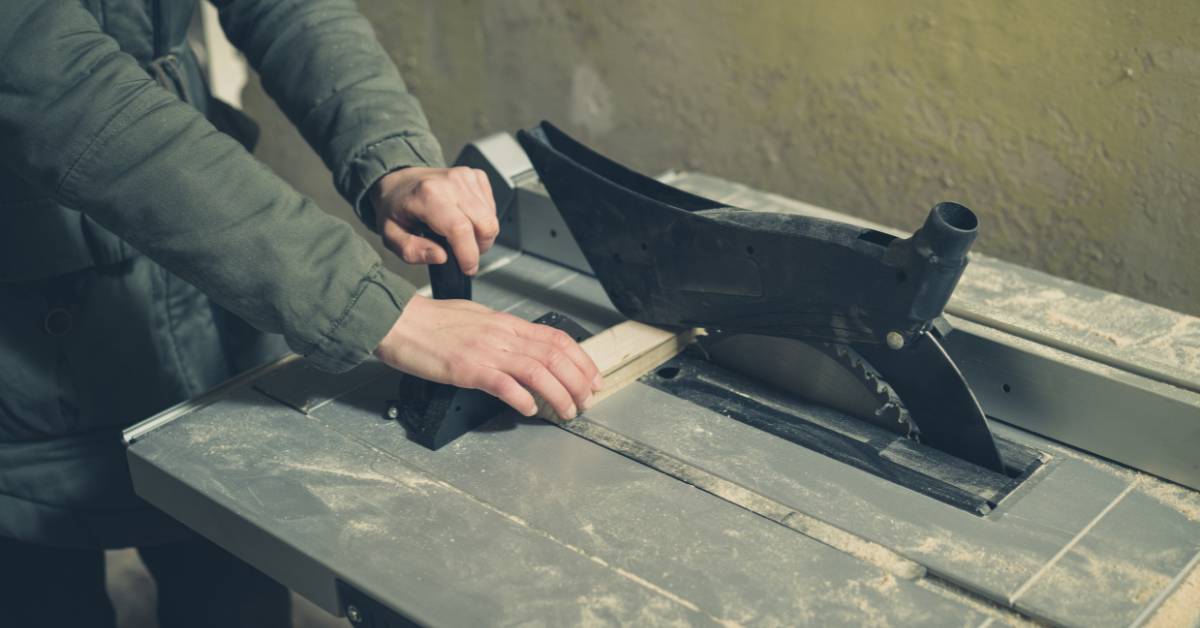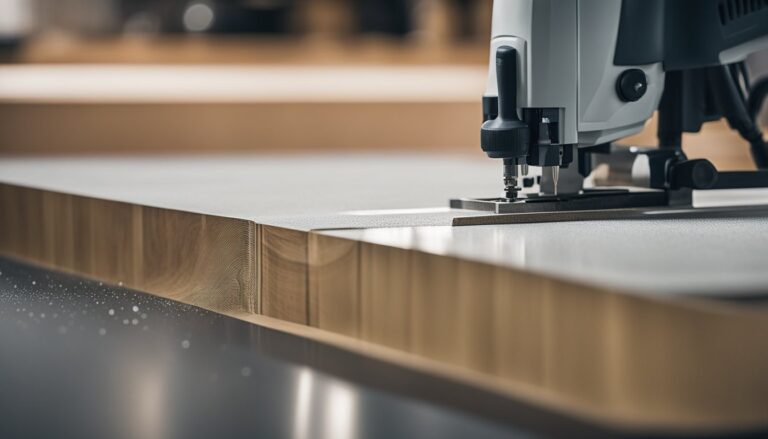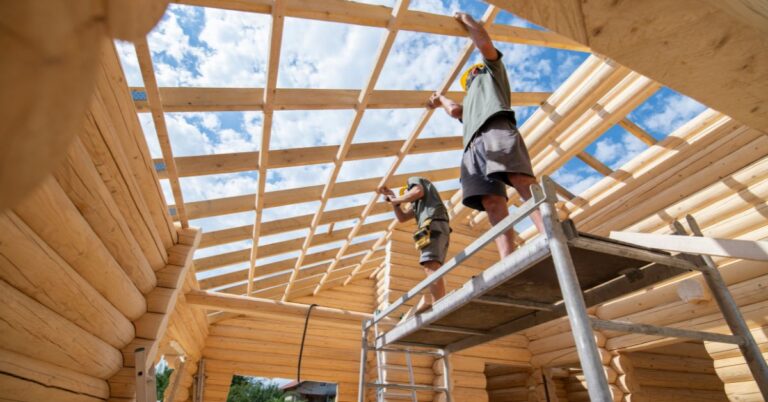Maximize Your Woodworking Potential: Top Table Saws For Efficient, Precise Cuts
Introduction
Woodworking is an art that requires precision, efficiency, and a deep understanding of materials and tools. The table saw is one of the most essential tools in a woodworker’s arsenal. It is vital for making accurate and clean cuts, enabling us to bring our designs to life quickly. With a top-quality table saw, we can maximize our woodworking potential and ensure the best results for our projects.
A wide range of table saws is available on the market, each with unique features and capabilities. As experienced woodworkers, we understand the importance of finding the right table saw that meets our needs and allows us to work effectively and efficiently. To help us make the most informed decision, we have compared and analyzed the top table saw machines, focusing on their cutting precision, reliability, and overall performance.
This article will share insights and information from our research, presenting you with the best table saws to enhance your woodworking potential. This knowledge will empower you to make an informed decision that ultimately contributes to the success and enjoyment of your woodworking journey.
Types of Table Saws
In the woodworking world, various types of table saws are available, each with advantages and purposes. We will discuss the main types: cabinet saws, contractor table saws, hybrid table saws, portable table saws, and stationary table saws.
Cabinet Saws are the largest, heaviest, and most powerful type of table saw. They are typically made with cast iron and steel, which adds to their stability and accuracy. They come with powerful motors, true to their name, enclosed in a cabinet base. The tabletop surface is larger than other types of saws and provides extended support for large or thick materials. Cabinet saws are favoured by professional woodworkers and cabinet makers, who require high precision in their cuts.
Contractor Table Saws are designed for job site use, being lighter and more portable than cabinet saws but still offering good power and accuracy. They usually have an open base with less metal for construction, making them easier to transport. Contractor saws are versatile and can handle various cutting tasks without taking up as much space as cabinet saws. Professionals and DIY enthusiasts often choose contractor table saws for their affordable price and satisfactory performance.
Hybrid Table Saws are a blend of cabinet and contractor saws, offering a balance between power, portability, and affordability. They typically come with a smaller motor than a cabinet saw but are enclosed similarly, helping to reduce vibrations and noise. Hybrid table saws have gained popularity among woodworkers who need a saw capable of precision but want to invest in something other than a large, heavy cabinet saw.
Portable Table Saws are the lightest and most compact type of table saw, perfect for those who need to move their saw between job sites or work in a small workshop. These saws usually have an aluminium or plastic base, making them lightweight and easily transported. Portable table saws sacrifice power and precision compared to other types of saws. Still, they are valued for their convenience and small footprint, ideal for hobbyists, DIYers, or those who don’t require heavy-duty cutting.
Stationary Table Saws are, as the name suggests, not intended for easy transportation. These saws, including cabinet saws and some hybrid models, prioritize power and accuracy over mobility. Stationary table saws have a solid base made from cast iron or steel, providing an immovable platform for highly accurate cuts. They suit professional woodworkers who need a stable and powerful machine in their workshop.
Each table saw type caters to different power, portability, and accuracy needs. It is essential to assess your woodworking goals and requirements to choose the right table saw for your projects.
Top Table Saw Brands and Models
In the woodworking industry, numerous well-established brands provide high-quality table saws. We will discuss some of the top brands and models that can help improve your efficiency and precision while cutting.
Bosch is a renowned brand when it comes to tools and woodworking equipment. One of their top table saw models is the Bosch 4100-10, which offers excellent performance and advanced features like a Soft Start Motor and Constant Response Circuitry.
DeWALT is another tool industry powerhouse known for its yellow and black designs. Their popular table saw, the DeWALT DWE7491RS, features a rack and pinion fence system, which makes it easy to adjust the fence for precise cuts. This saw also comes with a rolling stand for easy transportation.
SawStop takes safety to a whole new level with their patented safety system that stops the saw blade on contact with skin. The SawStop PCS31230-TGP236 is one of their top models, offering advanced protection, accurate cuts, and a powerful motor.
SKIL is a brand known for providing quality tools at affordable prices. The SKIL TS6307-00 table saw comes with a folding stand for easy storage and transport and has a solid performance for its price point.
Delta has a long history in the woodworking industry, and its Delta 36-5052 model features a unique tubular stand for maximum support and stability. This saw suits various cutting tasks with a powerful 15 Amp motor and a smooth operating system.
Shop Fox is another reputable brand, and their Shop Fox W1819 model features solid construction and a riving knife for increased safety. Reliable performance and precision make it a great addition to any workshop.
Rockwell offers portable options with their BladeRunner X2. This lightweight, compact table saw is perfect for small-scale projects and easy transportation. While it may not have all the features of larger saws, it’s still an excellent addition for those looking for a more portable option.
In conclusion, these are some top table saw brands and models available. Each offers unique features and benefits that can help improve your woodworking potential, ensuring efficiency and precise cuts for your projects.
Essential Features for Efficiency and Precision
When maximizing your woodworking potential, a table saw has several essential features to look for to ensure efficiency and precision cuts. We’ll cover the most crucial ones in this section.
First, power is essential for smoothly cutting and handling various woodworking tasks. A table saw with a powerful motor will ensure it can handle dense materials like hardwood and make clean, fast cuts.
A good fence is critical for maintaining accuracy when making rip cuts. A well-designed fence should be easy to adjust, lock securely, and always parallel to the blade.
The mitre gauge helps achieve precise crosscuts and angled cuts. Ensure your table saw has a high-quality, adjustable mitre gauge that slides smoothly in the mitre slot and locks securely at desired angles.
A sharp and durable saw blade is necessary for achieving clean, efficient cuts. Choose a blade with the proper tooth count and type for the material you plan to cut. Carbide-tipped blades offer longer life and better performance.
Accuracy is crucial in woodworking, and your table saw should have a reliable, easy-to-read scale for setting rip width, bevel angle, and mitre angle.
Safety features, like anti-kickback pawls, are essential to protect you from potential hazards. These devices engage the workpiece to prevent it from being kicked back toward the user.
A table saw capable of quickly making angled or bevel cuts will expand your woodworking abilities. Look for a saw with a smooth and accurate tilting mechanism.
A cast iron table top and sturdy trunnions are crucial for maintaining stability, rigidity, and prolonged alignment. These features minimize vibration and enhance cutting accuracy.
Effective dust collection is essential for keeping your workspace clean and maintaining visibility while cutting. Consider a table saw with a built-in dust collection system or the ability to connect to a shop vacuum.
Lastly, a smooth, adjustable mitre slot is essential for guiding the mitre gauge and other accessories, contributing to precise cuts.
By focusing on these features, you can find the optimal table saw to maximize your woodworking potential and achieve efficiency and precision in your cuts.
Safety Considerations
When it comes to woodworking, safety should always be a top priority. This section will discuss essential safety considerations every woodworker should know when using a table saw.
First and foremost, it is crucial to wear proper safety gear while operating a table saw. This includes safety glasses, hearing protection, and a dust mask to protect your eyes, ears, and lungs from debris and noise. Additionally, pushing sticks and feather boards can help you maintain a safe distance from the blade and minimize the risk of injury.
Kickback is another critical safety concern when using a table saw. Kickback occurs when the saw blade catches the workpiece and forcefully propels it towards the operator. To prevent this, always use a riving knife or splitter. This device sits behind the blade and helps to prevent the workpiece from pinching the blade during a cut, which can lead to kickback.
Regarding safety features, investing in a table saw with a reliable blade guard system is vital. These systems typically consist of a transparent plastic barrier that covers the spinning blade, preventing accidental contact with the blade while still allowing you to see your cutting line. Some models even come with built-in dust collection, a safety benefit and promote a clean and organized workspace.
Another valuable safety feature to look for is a power-loss reset. This feature ensures the table saw will not turn on automatically after a power outage or if the power cord is accidentally unplugged. The saw will require manual activation, reducing the chances of accidental activation and potential injury.
Additionally, using a magnetic switch can enhance your table saw’s safety. A magnetic switch prevents the saw from starting up again after a power failure or unplugging. It typically needs to be manually reset, ensuring the saw won’t restart unexpectedly.
In conclusion, always prioritize safety when using a table saw. Invest in a machine with proper safety features like a riving knife, blade guard system, power-loss reset, and magnetic switch. Also, remember to wear the necessary safety gear and follow best practices to minimize the risk of injury. With these considerations in mind, you are well on your way to maximizing your woodworking potential while ensuring a safe and efficient experience.
Table Saw Blades and Accessories
Choosing the right table saw blades and accessories is essential when maximizing your woodworking potential. We will discuss various blades and accessories to help you achieve efficiency and precision cuts.
First and foremost, selecting the appropriate saw blade is paramount for your table saw. With different types of table saw blades available, choosing a blade designed for the specific material and cut you want to make is crucial. For example, a general-purpose blade is a versatile option that can make crosscuts and rip cuts in various materials. In contrast, a dedicated crosscut blade will yield smoother results for crosscuts.
Mitre cuts require a gauge, which helps guide and hold your workpiece at a specific angle as it passes through the blade. You can also attach a mitre gauge extension or fence to your existing mitre gauge for added stability and accuracy. Some table saws come with built-in mitre gauges, but you can also purchase aftermarket options that may offer improved precision.
In addition to saw blades and mitre gauges, jigs are another essential accessory to consider for your table saw. Jigs allow you to perform specialized cuts and repetitive tasks with ease. Some popular jigs include:
- Crosscut sleds: These jigs enable you to make accurate and repeatable crosscuts with more excellent safety than a standard mitre gauge.
- Tenon jigs: Tenon jigs help you cut precise tenons for joinery projects with accuracy and speed.
- Box joint jigs: These enable you to create uniform box joints for robust and attractive corner connections in your woodworking projects.
In conclusion, investing in the right table saw blades and accessories will help you unlock your woodworking potential. Take the time to choose the best blade suitable for your needs, and consider using jigs and other accessories to improve accuracy and efficiency in your cuts.
Power and Performance
When it comes to woodworking, having a table saw that delivers power and performance is essential. We understand the importance of having a machine that can precisely handle various cuts, especially when ripping through hardwoods.
Horsepower plays a crucial role in the performance of your table saw. Most table saws on the market range from 1.5 to 5 HP, with the higher HP providing more power for thicker and harder materials. For most woodworking tasks, a table saw with 3 HP will suffice as it can efficiently rip through most stock materials. However, a 4 or 5-HP motor would be better if you often work with hardwoods.
Ripping capacity is another essential aspect to consider. Many saws offer a standard rip capacity of 24 to 30 inches, accommodating most projects for a hobbyist woodworker. On the other hand, professional woodworkers may need a larger capacity of up to 52 inches for commercial applications. A precise fence system ensures rip cuts are accurate, giving optimal results.
To maximize your woodworking potential, it’s essential to have a table saw with dependable performance. Features like a smooth and durable arbour, high-quality trunnions, and a well-aligned blade contribute to the overall performance of the saw. Additionally, having a solid, flat surface with zero error plays a significant role in accuracy, preventing material movement during cutting.
Paying attention to the blade with the table saw is also essential. Choosing a blade with the proper tooth count and design ensures efficiency and precision in your cuts. For instance, a general-purpose blade with a high tooth count is suitable for making smooth, precise, and efficient cuts in various materials. In contrast, a blade designed exclusively for ripping will have fewer teeth and a more aggressive hook angle to clear out wood chips.
In conclusion, selecting a table saw with adequate power, a sizeable ripping capacity and a quality build will ensure outstanding performance and precise cuts. You can find the perfect tool to maximize your woodworking potential by considering your needs and the saw’s features.
Portability and Storage
As woodworkers, we understand the importance of having a portable and easy-to-store table saw. A job site table saw can make all the difference in maximizing our woodworking potential. This section will discuss various features that contribute to the portability and storage of top table saw machines.
One key factor for a portable saw is its weight and dimensions. A lighter and more compact table saw allows for easy transportation from one location to another. This is especially important for DIY enthusiasts working on projects in various locations.
Our top table saw recommendations come with a foldable or rolling mobile base. The mobile base makes transportation more accessible and provides stability during operation. When not in use, a foldable stand allows quick and hassle-free storage without taking up much space.
Additionally, some table saw machines have built-in handles and wheels for enhanced mobility. These features make moving the saw around effortlessly, even when working on uneven surfaces.
In summary, top table saw machines designed for efficiency and precision cuts come with features that improve portability and storage. These include a lightweight design, a mobile base, folding stands, and built-in handles and wheels. All these elements work together to provide a smooth and hassle-free woodworking experience for professional and DIY woodworkers alike.
Durability and Materials
When it comes to woodworking, durability is of utmost importance. We want to ensure that our table saws are robust enough to handle various projects, from cutting hardwoods to creating custom furniture. In this section, we will discuss the materials and factors contributing to a table saw’s durability and longevity.
One of the critical components of a table saw’s durability is the construction material. Steel is the most prevalent material for table saws’ frames and working surfaces. It provides a solid and stable structure that can endure continuous use, making it an excellent investment for those who regularly use their table saw. Other materials, such as cast iron, can offer a stable and sturdy build but are generally more expensive and heavier than steel.
When working with hardwoods, a table saw needs to have a powerful motor that can operate at high speeds without wearing down. Investing in a table saw with a higher horsepower motor will ensure that cuts are made efficiently and precisely, reducing stress on the machine and prolonging its life. Additionally, investing in quality blades is essential for maintaining the effectiveness of your table saw, as they will stay sharp longer and make cleaner cuts.
Effective cleaning and maintenance are vital in keeping a table saw running at its best. Sawdust and debris can accumulate on the machine, which can affect its performance and cause unnecessary wear. Routinely cleaning your table saw and implementing proper dust collection techniques (such as using a shop vac or dust collection system) will keep the machine in optimal condition.
Finally, proper storage is essential for maintaining the longevity of your table saw. Ideally, it should be stored in a dry and temperature-controlled environment, like a garage, to prevent moisture from causing rust or other damage and to protect it from extreme temperatures.
In conclusion, prioritize materials, motor strength, suitable blades, cleaning, and storage when looking for a durable table saw to maximize efficiency and precision cuts. With the right investment and care, your table saw will serve you well in all your woodworking endeavours.
Buying Guide for Table Saws
When choosing the perfect table saw for our woodworking projects, we must consider several factors to ensure efficiency and precision in our cuts. In this buying guide, we’ll discuss some critical aspects to remember.
First, we must decide the type of table saw that best suits our needs. A portable or benchtop table saw may be sufficient for hobbyists and DIYers working on smaller projects. However, a larger contractor, hybrid, or cabinet table saw will provide higher stability and improved accuracy for more serious woodworkers.
The size and style of our work area also play a role in this decision. Limited workshop space requires a sleeker, more compact table saw, while larger spaces can easily accommodate bulkier models. It’s also essential to evaluate storage options, especially if we plan to store the table saw when not in use.
The type of material we work with also impacts the table saw. Hardwoods and thicker materials require greater horsepower and a sturdier table. We should look for a table saw with a solid, flat cast-iron table to ensure stability. A powerful motor capable of handling these materials at various speeds is crucial to ensure efficient cuts.
We must also consider the quality and user-friendliness of the table saw’s components. Accurate measurements and flawless cuts rely on precise fence and mitre gauge systems. Ensure the fence is sturdy, easily adjustable, and won’t shift during cuts. Similarly, the mitre gauge should provide a secure hold and move smoothly along its track.
Safety is a vital factor to consider when choosing a table saw. Look for features such as a riving knife, anti-kickback pawls, and blade guards. A magnetic switch or emergency stop function is a bonus safety advantage.
Lastly, we should remember our budget. Factor in the initial cost and potential accessories and replacement parts expenditures. While it’s tempting to go for the cheapest option, it’s crucial to invest in a quality table saw that will meet our woodworking needs and stand the test of time.
By considering these factors, we can confidently select the ideal table saw to maximize our woodworking potential and achieve efficiency and precision in every cut we make.
Best Table Saws in Different Categories
When selecting the best table saws for woodworking, various options are based on your needs and budget. We have compiled our top picks for different categories, helping you maximize your woodworking potential by achieving efficiency and precision in your cuts.
Best Overall: The most versatile and efficient table saw, suitable for beginners and experienced carpenters, is the SawStop PCS175-TGP236 Professional Cabinet Saw. This powerful machine has advanced safety features, including a contact detection system that prevents accidents.
Best Budget: For those on a budget, the DEWALT DWE7485 Compact Jobsite Table Saw is a fantastic choice, offering excellent performance and portability at an affordable price. This saw is perfect for carpenters looking to achieve precise cuts without breaking the bank.
Best Portable: For carpenters who need a highly portable and durable power tool, the Bosch GTS1031 10-Inch Portable Jobsite Table Saw is the best option. With its compact design and one-handed carry handle, this table saw is perfect for those on-the-go projects.
Best Hybrid: Experienced carpenters seeking a robust and powerful contractor saw should consider the Shop Fox W1837 Open-Stand Hybrid Table Saw. This machine combines the stability of a cabinet saw with the power of a contractor saw, resulting in a highly efficient and precise tool.
Best Cordless: Regarding cordless table saws, the Milwaukee M18 FUEL 8-1/4″ Table Saw with One-Key (model 2736-21HD) is an excellent choice. Powered by a battery, this table saw offers maximum efficiency without sacrificing power or portability.
In conclusion, our choices for the best table saws in different categories showcase a range of options for carpenters, from budget-friendly to high-performance machines. Ultimately, the best table saw for your needs will depend on your specific woodworking projects, budget, and desired features.





